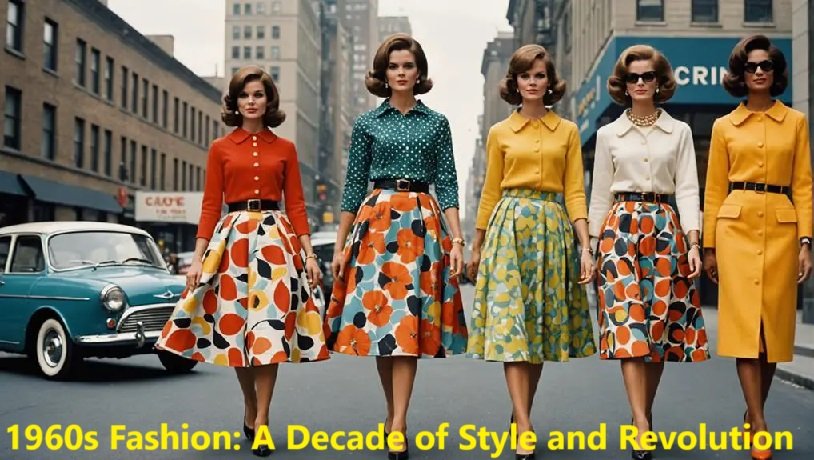The 1960s were a transformative decade that redefined fashion as an expression of freedom, individuality, and rebellion. This era witnessed the birth of iconic styles that still influence modern fashion trends today. The unique mix of classic elegance, counterculture, and futuristic designs has kept 1960s fashion in the limelight for decades. From mod fashion to hippie chic, let’s explore the various styles that shaped this revolutionary period in history.
The Rise of Mod Fashion: Clean Lines and Bold Patterns
One of the most notable fashion movements in the early 1960s was mod fashion. Short for “modernist,” mod fashion was defined by sleek, sharp silhouettes, bold patterns, and a youthful energy that embodied the social revolution of the time.
The Iconic Mini Skirt
The mini skirt, popularized by British designer Mary Quant, became the symbol of mod fashion. Cut several inches above the knee, it shocked traditionalists but resonated with a generation hungry for change. Women of the 1960s embraced the mini skirt as a sign of liberation, pairing it with knee-high boots or simple flats for a look that was both daring and playful.
Bold Geometric Prints and Colors
Mod fashion also embraced bold, geometric prints and vibrant colors like yellow, orange, and electric blue. Dresses and suits often featured sharp A-line cuts with minimal detailing, allowing the colors and patterns to take center stage. Black and white optical prints, in particular, were a hallmark of mod fashion, adding a sense of futurism to everyday wear.
Shift Dresses
The shift dress became another essential piece in the mod wardrobe. With its straight, boxy shape and lack of a defined waistline, the shift dress provided comfort and freedom of movement. Often adorned with contrasting collars and cuffs, it was an effortlessly chic garment that could be dressed up or down.
The Influence of Music and Youth Culture
The 1960s was a time when music played an integral role in shaping fashion trends. The British Invasion, led by bands like The Beatles and The Rolling Stones, brought a new sense of style to the masses. The musicians themselves became fashion icons, influencing everything from hairstyles to clothing choices.
The Beatles and Their Suits
The Beatles, with their matching suits and clean-cut looks, initially promoted a polished, sophisticated style. However, as their music evolved, so did their fashion choices. By the late 1960s, they embraced more eclectic and flamboyant styles, featuring paisley prints, bell-bottoms, and embroidered jackets.
Bohemian and Hippie 1960s Fashion
By the mid-1960s, bohemian and hippie fashion took center stage, heavily influenced by the countercultural movement and the ethos of peace, love, and freedom. This style was a direct reaction to the stiff, formal fashions of previous decades, embracing comfort, natural fabrics, and a relaxed silhouette.
Fringes, Bell-Bottoms, and Psychedelic Prints
Hippie fashion was characterized by the use of fringes, bell-bottom pants, and psychedelic prints. Tie-dye shirts, long flowing skirts, and beaded accessories became staples of the era, reflecting the vibrant, free-spirited lifestyle of the counterculture.
The Maxi Dress 1960s Fashion
In contrast to the short and structured mini skirts of mod fashion, the maxi dress emerged in the late 1960s as a long, flowing alternative. Often made from lightweight, floral fabrics, maxi dresses exude a bohemian charm that is perfect for music festivals and outdoor gatherings. This laid-back style was a key element of the hippie aesthetic, offering a sense of freedom and ease.
Futuristic and Space Age Influence 1960s Fashion
The 1960s was also an era of technological advancements and a fascination with space exploration, which greatly influenced the fashion world. Designers such as Pierre Cardin and André Courrèges began experimenting with futuristic designs that reflected society’s growing interest in the space race.
Metallic Fabrics and Sleek Silhouettes
Space Age fashion often featured metallic fabrics, plastic materials, and innovative shapes that pushed the boundaries of traditional fashion. Designers embraced vinyl, PVC, and other synthetic materials to create garments that looked ahead to a new, high-tech future.
Go-Go Boots 1960s Fashion
Go-go boots, which were introduced in the mid-1960s, became a major fashion statement of the era. These knee-high, low-heeled boots were often made from shiny, white patent leather and paired with short skirts or dresses. Go-go boots embodied the playful, futuristic spirit of the decade and remain an enduring symbol of 1960s fashion.
The Social and Political Impact on Fashion
The 1960s was a decade marked by significant social and political upheaval, including the Civil Rights Movement, the women’s liberation movement, and widespread protests against the Vietnam War. These events had a profound impact on the way people dressed, as fashion became a tool for making bold statements.
Unisex Fashion 1960s Fashion
As gender roles began to shift, unisex fashion gained popularity. Both men and women began to adopt similar clothing styles, with items like turtlenecks, flared pants, and military jackets becoming popular for both sexes. The idea that fashion could transcend gender was revolutionary at the time and reflected the growing push for equality.
The Rise of Black Pride Fashion
The 1960s also saw the rise of black pride fashion, with African Americans embracing natural hairstyles and traditional African clothing as symbols of cultural pride and resistance to systemic oppression. Afros and dashikis became prominent, representing a powerful rejection of Eurocentric beauty standards and a celebration of African heritage.
Legacy of 1960s Fashion
The fashion trends of the 1960s continue to resonate today, with designers regularly drawing inspiration from the era’s bold and innovative styles.This decade not only revolutionized how people dressed but also redefined fashion’s role in society. The 1960s taught us that clothing is more than just fabric – it’s a reflection of our beliefs, values, and the cultural moment we are living in.
Read More: Fashion Show Mall
